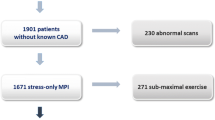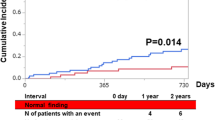Abstract
Background
This study examined the independent and incremental prognostic value of exercise thallium single-photon emission computed tomographic imaging in 212 women who also underwent coronary angiography.
Methods and Results
The left ventricular ejection fraction was normal (65%±15%). During a mean follow-up of 40 months, 27 women had events (cardiac death or nonfatal myocardial infarction). Univariate Cox survival analysis showed several variables to be different between patients with events and those without events: age, exercise heart rate, the extent of coronary artery disease, reversible thallium defects, number of segments with reversible abnormality, and size of perfusion abnormality. Multivariate survival analysis showed that a large perfusion abnormality and age were the independent predictors of events. Actuarial life-table analysis showed that women with a large thallium abnormality (≥15% of the myocardium) had significantly worse event-free survival rates than had women with no or small abnormalities (Mantel-Cox statistic=16; p=0.0001).
Conclusions
Thus exercise thallium-201 single-photon emission computed tomographic imaging provides independent and incremental prognostic information to clinical, exercise, and coronary angiographic results in women. The presence of a larger thallium abnormality identifies women at high risk of cardiac events.
Similar content being viewed by others
References
Lerner DJ, Kannel WB. Patterns of coronary heart disease morbidity and mortality in the sexes. A 26-year follow-up of the Framingham population. Am Heart J 1986;111:383–90.
Iskandrian AS, Chae SC, Heo J, Stanberry C, Wasserleben V, Cave V. Independent and incremental prognostic value of exercise single-photon emission computed tomographic (SPECT) thallium imaging in coronary artery disease. J Am Coll Cardiol 1993;22:665–70.
Pollock SG, Abbott RD, Boucher CA, Beller GA, Kaul S. Independent and incremental prognostic value of tests performed in hierarchical order to evaluate patients with suspected coronary artery disease: validation of models based on these tests. Circulation 1992;85:237–48.
Abdel Fattah A, Kamal AM, Aksut S et al. Prognostic value of adenosine single-photon emission computed tomographic thallium imaging in medically treated patients with angiographic evidence of coronary artery disease. J Nucl Cardiol 1994;1:254–61.
Heo J, Iskandrian AS. Stress thallium imaging. Am J Noninvas Cardiol 1991;5:173–84.
Iskandrian AS, Heo J, Askenase A, Segal BL, Helfant RH. Thallium imaging with single photon emission computed tomography. Am Heart J 1987;114:852–65.
Iskandrian AS, Heo J, Kong B, Lyons E. Effect of exercise levels on the ability of thallium-201 tomographic imaging in detecting coronary artery disease: analysis of 461 patients. J Am Coll Cardiol 1989;14:1477–86.
Stone PH, Muller JE, Hartwell T, et al. The effect of diabetes mellitus on prognosis and serial left ventricular function after acute myocardial infarction: contribution of both coronary artery disease and diastolic left ventricular dysfunction to adverse prognosis. J Am Coll Cardiol 1989;14:49–57.
Chae SC, Heo J, Iskandrian AS, Wasserleben V, Cave V. Identification of extensive coronary artery disease in women by exercise single-photon emission computed tomographic (SPECT) thallium imaging. J Am Coll Cardiol 1993;21:1305–11.
Garcia EV, DePuey EG, Sonnemaker RE, et al. Quantification of the reversibility of stress-induced thallium-201 myocardial perfusion defects: a multicenter trial using bull’s eye polar maps and standard normal limits. J Nucl Med 1990;31:1761–5.
Iskandrian AS, Heo J, Nguyen T, Lyons E, Paugh E. Left ventricular dilation and pulmonary thallium uptake after single-photon emission computer tomography using thallium-201 during adenosine-induced coronary hyperemia. Am J Cardiol 1990;66:807–11.
Heo J, Thompson WO, Iskandrian AS. Prognostic implications of normal exercise thallium images. Am J Noninvas Cardiol 1987;1:209–12.
Hopkins A. Survival analysis with Cox models: BMOP statistical software. Los Angeles: University of California Press, 1983.
Wenger NK. Coronary disease in women. Ann Rev Med 1985;36:285–94.
Kannel WB, Sorlie P, McNamara PM. Prognosis after initial myocardial infarction: the Framingham Study. Am J Cardiol 1979;44:53–61.
Weinblatt E, Shapiro S, Frank CW. Prognosis of women with newly diagnosed coronary disease: a comparison with course of disease among men. Am J Public Health 1975;37:593–7.
Brown KA. Prognostic value of thallium-201 myocardial perfusion imaging: a diagnostic tool comes of age. Circulation 1991;83:363–81.
Iskandrian AS, Johnson J, Le TT, Wasserleben V, Cave V, Heo J. Comparison of the treadmill exercise score and single-photon emission computed tomographic thallium imaging in risk assessment. J Nucl Cardiol 1991;1:144–9.
Ladenheim ML, Pollock BH, Rosarski A, et al. Extent and severity of prognosis in patients with suspected coronary artery disease. J Am Coll Cardiol 1986;17:464–71.
Staniloff HM, Forrester JS, Berman DS, Swan HJC. Prediction of death, myocardial infarction and worsening chest pain using thallium scintigraphy and exercise electrocardiography. J Nucl Med 1986;27:1842–8.
Iskandrian AS, Hakki AH, Kane-Marsch S. Prognostic implications of exercise thallium-201 scintigraphy in patients with suspected or known coronary artery disease. Am Heart J 1985;110:135–43.
Cowley MJ, Mullin SM, Kelsey SF, et al. Sex differences in early and long-term results of coronary angioplasty in the NHLBI PTCA registry. Circulation 1985;71:90–9.
Loop FS, Golding LR, MacMillan JP, et al. Coronary artery surgery in women compared with men: analysis of risks and long term results. J Am Coll Cardiol 1983;4:383–7.
Aksut S, Mallavarapu C, Russell J, Iskandrian AS. Lung thallium uptake by SPECT thallium imaging. J Nucl Med 1994;35:126P.
Lee KL, Pryor DB, Pieper KS et al. Prognostic value of radionuclide angiography in medically treated patients with coronary artery disease: a comparison with clinical and catheterization variables Circulation 1990;82:705–17.
Iskandrian AS, Heo J. Pharmacologic stress testing. In: Zaret B, Beller G, eds. Nuclear cardiology. St. Louis: Mosby, 1993:170–80.
Iskandrian AS, Verani MS, Heo J. Pharmacologic stress testing: mechanism of action, hemodynamic responses and results in detection of coronary artery disease. J Nucl Cardiol 1994;1:94–111.
Author information
Authors and Affiliations
Rights and permissions
About this article
Cite this article
Pancholy, S.B., Fattah, A.A., Kamal, A.M. et al. Independent and incremental prognostic value of exercise thallium single-photon emission computed tomographic imaging in women. J Nucl Cardiol 2, 110–116 (1995). https://doi.org/10.1016/S1071-3581(95)80021-2
Received:
Accepted:
Issue Date:
DOI: https://doi.org/10.1016/S1071-3581(95)80021-2




